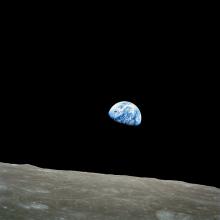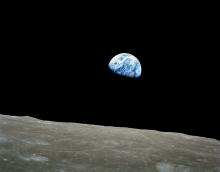Listen to today's episode of StarDate on the web the same day it airs in high-quality streaming audio without any extra ads or announcements. Choose a $8 one-month pass, or listen every day for a year for just $30.
You are here
Moon and Spica
When Earth was born, the Sun was fainter than it is today — by about 30 percent. That should have made the young Earth a snowball. But evidence shows that Earth had liquid water on its surface not long after it was formed. That leaves scientists wondering where the extra heat came from.
Some of it might have been provided by the Moon. It was born shortly after Earth itself. A planet as big as Mars slammed into Earth, blasting debris into space. Some of that material quickly coalesced to form one or more moons. Today, only one remains.
The newborn Moon was quite close to Earth — less than one-tenth of its current distance. At that range, its gravitational pull on Earth was much stronger than it is today. That created powerful tides in whatever water stood on the surface — and in the solid planet.
A recent study says those tides would have stretched and compressed rock at and below the surface. That would have generated heat, melting the rocks. That could have boosted the birth of volcanoes, which spewed carbon dioxide and other greenhouse gases into the atmosphere. Combined, that would have warmed the surface by several degrees — accounting for at least some of the heat needed to take up the slack of the weaker Sun.
The Moon is full tonight. It’s the Egg Moon or Grass Moon. And it has a bright companion: Spica, the leading light of Virgo. It rises below the Moon in early evening, and the Moon slides closer to it throughout the night.
Script by Damond Benningfield





